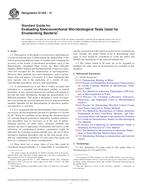Potrebujeme váš súhlas na využitie jednotlivých dát, aby sa vám okrem iného mohli ukazovať informácie týkajúce sa vašich záujmov. Súhlas udelíte kliknutím na tlačidlo „OK“.
ASTM E1326-13
Standard Guide for Evaluating Nonconventional Microbiological Tests Used for Enumerating Bacteria
Automaticky preložený názov:
Štandardné Guide pre hodnotenie netradičné Mikrobiologické testy, používané pre Výpočet baktérie
NORMA vydaná dňa 1.10.2013
Informácie o norme:
Označenie normy: ASTM E1326-13
Poznámka: NEPLATNÁ
Dátum vydania normy: 1.10.2013
Kód tovaru: NS-41311
Počet strán: 4
Približná hmotnosť: 12 g (0.03 libier)
Krajina: Americká technická norma
Kategória: Technické normy ASTM
Anotácia textu normy ASTM E1326-13 :
Keywords:
ICS Number Code 07.100.10 (Medical microbiology)
Doplňujúce informácie
| Significance and Use | ||||||||||||||||
|
5.1 This guide should be used by producers and potential producers of nonconventional tests to determine the accuracy, selectivity, specificity, and reproducibility of the tests, as defined in Practices E691 and D3870. Results of such studies should identify the limitations and indicate the utility or applicability of the nonconventional test, or both, for use on different types of samples. 5.2 Nonconventional test users and potential users should employ this guide to evaluate results of the nonconventional test as compared to their present methods. Practices D5245 and D5465 should be reviewed in regards to the conventional microbiological methods employed. If conventional methods have not been used for monitoring the systems, then guidelines are included for obtaining microbiological expertise. 5.3 Utilization of a nonconventional test may reduce the time required to determine the microbiological status of the system and enable an improvement in the overall operating efficiency. In many cases, the findings of a significantly high level of bacteria indicates the need for an addition of an antimicrobial agent. By accurately determining this in a shorter time period than by conventional methods, treatment with antimicrobial agents may circumvent more serious problems than if the treatment were postponed until conventional results were available. If the antimicrobial treatment program relies on an inaccurate nonconventional test, then unnecessary loss of product and problems associated with inappropriate selection or improper dosing with antimicrobial agents would exist. 5.4 Since many methods based on entirely different chemical and microbiological principles are considered, it is not possible to establish a unique design and recommend a specific method of statistical analyses for the comparisons to be made. It is only possible to present guides that should be followed while performing the experiments. It is also recommended that a statistician be involved in the study. 5.5 There are various ways for categorizing microbiological test methods. One valid approach is to differentiate between methods intended to quantify a particular microbe from those intended to quantify overall bioburden. 5.5.1 Methods used to quantify a single microbe typically can be evaluated for precision (Practice E691). Even though it is unlikely that reference standards exist, often these methods can also be evaluated for bias relative to other methods used to detect the same microbe. 5.5.2 Methods used to quantify total populations are more problematic in terms of precision and bias testing. Guide D7847 addresses many of the factors that confound efforts to determine the precision of microbiological test methods used to quantify microbial contamination in fuels and fuel systems. Many of these issues are broadly relevant to the challenge of developing relevant precision terms for microbiological test methods used to quantify total bioburdens in industrial systems. |
||||||||||||||||
| 1. Scope | ||||||||||||||||
|
1.1 The purpose of this guide is to assist users and producers of nonconventional tests in determining the applicability of the test for processing different types of samples and evaluating the accuracy of the results. Conventional procedures such as the Heterotrophic (Standard) Plate Count, the Most Probable Number (MPN) method and the Spread Plate Count are widely cited and accepted for the enumeration of microorganisms. However, these methods have their limitations, such as performance time and degree of accuracy. It is these limitations that have recently led to the marketing of a variety of non-conventional procedures, test kits and instruments. 1.2 A conventional test is one that is widely accepted and published as a standard microbiological method or related procedure. A new, nonconventional test method will attempt to provide the same information through the measurement of a different parameter. This guide is designed to assist investigators in assessing the accuracy and precision of nonconventional methods intended for the determination of microbial population densities or activities. 1.3 It is recognized that the Heterotrophic Plate Count does not recover all microorganisms present in a product or a system (1, 2).2 When this problem occurs during the characterization of a microbiological population, alternative standard enumeration procedures may be necessary, as in the case of sulfate-reducing bacteria. At other times, chemical methods that measure the rates of appearance of metabolic derivatives or the utilization of contaminated product components might be indicated. In evaluating nonconventional tests, the use of these alternative standard procedures may be the only means available for establishing correlation. In such cases, this guide can serve as a reference for those considerations. 1.4 Since there are so many types of tests that could be considered nonconventional, it is impossible to recommend a specific test protocol with statistical analyses for evaluating the tests. Instead, this guide should assist in determining what types of tests should be considered to verify the utility and identify the limitations of the nonconventional test. 1.5 The values stated in SI units are to be regarded as standard. No other units of measurement are included in this standard. |
||||||||||||||||
| 2. Referenced Documents | ||||||||||||||||
|




 Cookies
Cookies
